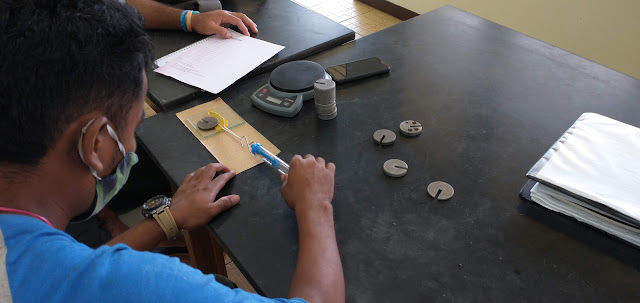Laboratory four
In this online term the conservation of marble momentum was moved to Wednesday as an at home exploration. The exploration of the conservation of gravitational potential energy and kinetic energy was shifted to the Thursday lab class. This term I opted to bring leaves from home as I have a good supply now on the west side of the house. I brought extras, which allowed me to swap out leaves as needed after the first class.
A poll of students indicated only one student had watched the Wednesday momentum video and none had tried the exercise outlined in the video. I went ahead and had the students engage with the momentum experiment at the start of the 8:00 section.
Marlin and Hart
One group sought to simplify the vertical measurement and improve the accuracy of that measurement. Error in the height measurement has always been a factor. If the height measurement is off by one centimeter either way, then the velocity could vary by up to ±3 cm/s away from the predicted 311 cm/s for a release height of 50 cm. This is an error of less than one percent, a percentage error that decreases with height for a given raw error. The underlying relationship, v ~ k√h, ensures that any error in h has a reduced, not magnified, effect on the velocity.

Height is measured vertically from the table, which usually involves sighting horizontally across the banana leaf. The data obtained by this group with their modified rig did not differ significantly from that of other groups using an intact leaf. Too, there was a loss in the structural integrity of the leaf - the leaf may have sagged slightly more under the influence of the weight of the marble. That sag could contribute to changes in the dynamics of the marble rolling on the leaf - the longer the marble spends on relatively flatter leaf sections, the more opportunity for friction induced slowing to occur.
Pendura and Jaylino work with an intact leaf
Carmina, MJ, and Belsin
Carmina records data directly into
DesmosJeimy, Semihma, JacyAnn
Rhea, Rojane, Miyuki
The small class size lets the group remain well spaced from each other. With no Covid-19 cases on island and the island still sealed off from the world, masks remain a training exercise.
Left board end of 8:00 section
Right board partially erased after 8:00 section
Derivation on left board at end of 11:00 section replaced momentum coverage
Right board after 11:00 section
Laboratory five
Marlin and Hart tackle the effect of surface area on friction.
The multi-stack louver glass sled for surface area work
Belsin measuring the effect of weight on the force of friction
Harvey teamed up with Pendura as both have arrived late
Rhea, Loyida
JacyAnn, Semihma, Kayleen
Kayleen pulls the sled
Afternoon class also well spaced apart
Boards at the end of the day
Data set one is weight versus force of friction for which there is a clear and strong linear relationship. The slope is the coefficient of kinetic friction.
Data set two is grit size versus force of friction. If there is a relationship, the relationship is potentially negative.
Data set three in blue is surface area data, the force fluctuated somewhat randomly up and down, the slope is probably spurious and is unduly influenced by the smallest surface area and largest surface area.




























Comments
Post a Comment